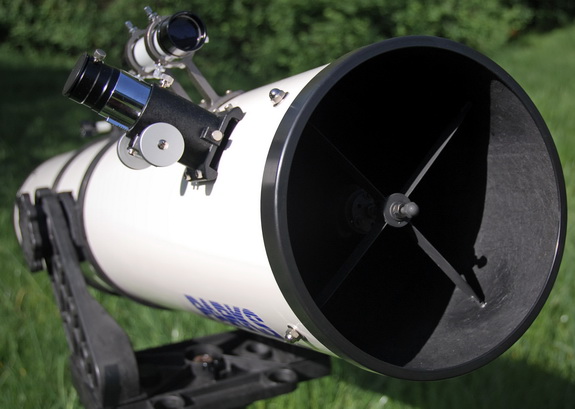
The Newtonian reflector is one of the most versatile optical configurations ever created. Whether homebuilt or commercially manufactured, a good Newtonian can rival the performance of any optical design.
Knowledge is power. The more you know about your Newtonian reflector’s potential and its pitfalls, the better equipped you’ll be to ensure it’s delivering peak performance.
In my experience, a well made and adjusted reflector is capable of holding its own against a premium apochromatic refractor — an instrument synonymous with optical perfection. Yet many, many scopes fall short of this benchmark. Why?
Partly it’s because the comparison is inherently unfair. Good optics and precision mechanics cost money, and to a large extent, you get what you pay for. A $400 Dob is unlikely to keep up with a $4,000 state-of-the-art apo. But several factors regularly contribute to the reflector’s shortcomings. Based on my years of experience building and using telescopes, here is my take on the five biggest reasons your reflector may be falling short of perfection, listed in order of increasing importance.
5. Obstruction. Much has been written on the subject of the central obstruction and its impact on fine planetary detail. It remains a hot-button topic in on-line forums, and yet, despite the intensity of the debate, obstruction effects are well understood and fairly simply to quantify. The issue was most elegantly summarized by William Zmek in the July 1993 issue of Sky&Telescope magazine. Zmek’s rule of thumb states that if you subtract the diameter of the obstruction from the objective, you have the equivalent unobstructed instrument when it comes to contrast resolution.
In other words, an 8-inch reflector with a 1.5-inch obstruction has the potential to resolve the same low-contrast planetary detail as an unobstructed 6.5-inch scope. However, when the obstruction is less than 20% the diameter of the main mirror, the effects become very difficult to see at all. Short of rebuilding your scope with a low-profile focuser and smaller secondary mirror, this is something you’re mostly likely going to have to accept as inherent in the design. You can learn about how to correctly size your telescope’s secondary mirror here.
4. Baffling. I’ve seen Newtonians that are well baffled against stray light, and others that allow all kinds of unwanted illumination to pollute the view. The difference is usually due to knowing what effective baffling looks like. You don’t need to install an elaborate set of ring baffles like those found in refractors (in fact, I recommend against doing so), but you should make a modest effort to ensure that the only light reaching your eyepiece is coming from your primary mirror. The easiest way to confirm this is to put a collimation plug in the focuser, and have a look. If you can see the ground behind the primary mirror, or look past the top of the telescope tube, you have some work to do.
3. Optical quality. Optical quality matters, but these days it’s usually not the main problem. Most of the commercial mirrors I’ve evaluated in the past 10 years have been pretty good — a few have even been excellent. That’s not to say there aren’t duds out there, but if your telescope isn’t performing, the items that top this list are more likely to be the reason. Usually, differences in optical quality distinguish a good telescope from one that is excellent, not one that is poor from one that is very good. Still, if you can rule out all other causes, the quality of your scope’s primary mirror might be suspect. Fortunately, a simple star test can help you figure out if this is the case. The best how-to guide on the subject remains Dick Suiter’s excellent book, Star Testing Astronomical Telescopes (Willmann-Bell).
2. Poor thermal management. This is near the top of my list for two reasons. First, a warm telescope mirror can significantly harm image quality — especially at medium to high magnifications. Secondly, the problem is often misdiagnosed as bad atmospheric seeing, and as such, is simply ignored. If your scope has a good mirror, adequate baffling, and is properly collimated, and still doesn’t deliver good planetary views, almost certainly, this is the cause. Unlike a central obstruction, thermal problems are not inherent in a Newtonian — there’s no reason to live with them. The solution is to install a fan and use it. You can read my two-part article on thermals here and here.
1. Collimation. This is a biggie. Poorly collimated optics can make a stellar mirror look downright bad. But there’s good news here too. Misalignment is a problem you can easily remedy with some careful and methodical adjustment — something every reflector owner needs to know how to do. Being unable to collimate your scope is like owning a guitar without understanding how to tune it. Learn basic collimation, and check your scope’s optical alignment regularly. An inexpensive collimation plug (like those often supplied with beginner telescopes) is the only tool you really need. You can read my Beginner’s Guide to Collimation here.
No telescope is perfect — every instrument has its shortcomings, some of which are simply part of the design, while others arise from how the design is implemented. But there’s a difference between “perfect” and “useful.” Although we should do what we can to make sure our scopes are running well, don’t get so obsessed with absolute perfection that you never take the time to enjoy the wonders that even an imperfect scope can show you.
Did you find this article interesting or helpful? If so, consider using this link the next time you shop at Amazon.com. Better yet, bookmark it for future use. Thanks to Amazon’s associates program, doing so costs you nothing yet helps keep this site up and running. Thanks!
Note: This is an updated and expanded version of an article that appeared in the August 2012 issue of Sky&Telescope magazine.
